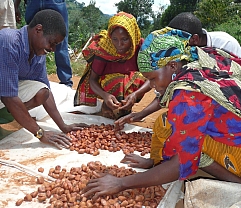Farmlands Worldwide Have Significant Tree Cover: Study.

 |
|
Farmers in Tanzania and Ghana benefit from trade in Allanblackia seeds |
The findings were announced at the opening of the 2nd World Congress of Agroforestry, which is being held in
This is the first study to quantify the extent to which trees are a vital part of agricultural production in all regions of the world. It reveals that on more than 1 billion hectares—which make up 46 percent of the world’s farmlands and are home to more than half a billion people—tree cover exceeds 10 percent.
“The area revealed in this study is twice the size of the Amazon, and shows that farmers are protecting and planting trees spontaneously,” says Dennis Garrity, the Centre’s Director General. “The problem is that policymakers and planners have been slow to recognize this phenomenon and take advantage of the beneficial effect of planting trees on farms. Trees are providing farmers with everything from carbon sequestration, to nuts and fruits, to windbreaks and erosion control, to fuel for heating and timber for housing. Unless such practices are brought to scale in farming communities worldwide, we will not benefit from the full value trees can bring to livelihoods and landscapes.”
From the data presented in the study, it is not possible in all cases for the researchers to discern precisely the products and services that trees are providing. However, a great deal of previous agroforestry research has documented a wide range of uses for trees on farms, including: fertilizer trees for improving crop yields and enhancing soil health; fruit trees for nutrition; fodder trees to feed livestock; timber and fuelwood trees to provide shelter and energy; medicinal trees; and trees that provide global commodities such as coffee, rubber, nuts, gums and resins. As equally important on the service side are uses such as erosion control, water quality and biodiversity.
“If planted systematically on farms, trees could improve the resiliency of farmers by providing them with food and income,” says Tony Simons, Deputy Director General at the World Agroforestry Centre. “For example, when crops and livestock fail, trees often withstand drought conditions and allow people to hold over until the next season.”
“What trees essentially provide to farmers is choice. Choice of enterprise, choice of market, choice for diversification, choice for low labour requirement, choice for multiple function,” Simons continues. “Developing country farmers are spoilt for choice. Whilst Western Europe has some 250 native tree species and
Previous estimates for the amount of farmland devoted to agroforestry have ranged from as low as 50,000 hectares to as high as 307 million hectares. But these estimates were not derived from detailed remote sensing data as was employed in this assessment. In this study, scientists were able to measure the amount of tree cover on each square kilometer of the world’s 22.2 million square kilometers of farmland.
The scientists—who include researchers from the International Centre for Integrated Mountain Development and the Katholieke Universiteit Leuven in
Their data also show that people live with trees in farmed landscapes in virtually all of Central America, and in about 80 percent of such landscapes in Southeast Asia and South
“This study offers convincing evidence that farms and forests are in no way mutually exclusive, but that trees are in fact critical to agricultural production everywhere,” says Professor Wangari Maathai, founder of the Green Belt Movement. Professor Maathai was awarded the 2004 Nobel Peace Prize for work that included planting more than 30 million trees to provide food, fuel, shelter and income for Africa’s rural poor.
Challenging commonly held assumptions
Most notably, the researchers reveal that globally, there is no consistent tradeoff “between people and trees.” There are areas with low population and little tree cover, and areas with lots of people and lots of trees.The amount of tree cover—low or high—can not be explained solely by climate conditions, they say.
“This underlines the importance of other factors,” the study states, such as land tenure rights, markets, or “other policies and institutions,” which influence tree planting, retention and management.
The authors also point to “documented cases” in which forests are initially cleared for agriculture development, but tree cover later returns, at least partially, as farmers seek to enhance production by planting useful trees that can generate income or provide other services, such as protecting watersheds.
According to experts at the World Agroforestry Centre, farmers, particularly in developing countries, would adopt various agroforestry practices more rapidly if their trees were included in international climate change mitigation schemes now under development.
Trees and climate change
Climate change talks set to take place later this year in Copenhagen will consider a new strategy focused on Reduced Emissions from Deforestation and Forest Degradation (REDD), which could include payments for carbon captured by trees and soils. Experts are discussing ways to ensure that agroforestry is part of the REDD investment mechanisms. The World Agroforestry Centre and the United Nations Environment Programme (UNEP) are developing a standard method for measuring carbon storage on all types of landscapes, which could provide a basis for providing farmers with a financial incentive to increase tree cover on their farms.
“The data in this report illustrate that agroforestry will be critical to efforts aimed at making agriculture more productive and sustainable in order to contribute to the alleviation of climate change,” says Garrity. “It is estimated that further investments in agroforestry over the next 50 years could remove significant amounts of carbon dioxide from the atmosphere.”
The authors caution that the study may have underestimated the global extent of tree cover on farmlands. For example, the researchers used a system for classifying land as “agriculture land” that likely missed many areas—particularly in Africa—so dominated by tree crops that they were classified as forests, not “agroforests.” However, scientists anticipate improved datasets will soon be available that will do a better job of identifying forested areas that are being used predominantly for agriculture purposes.
Courtesy: World Agroforestry Centre
